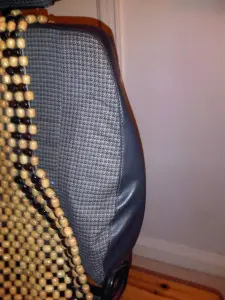How to Refurbish, Upgrade and Fit Exmoor Trim Defender Heated Seats
In this post we’ll take you through why we needed to fix our Land Rover Defender seats, which still had the original fabric, we’ll show you how we did the re-trim and give you a review of Exmoor Trims Outlast Seat Covers.
When we got the Landy one of the negative points was the state of the interior and the seats. The fabric was horrible, torn in places, smelt bad and the seat squabs (foams) were collapsing.

At some stage, we would need to re-upholster the interior. Additionally in the back, the standard second-row seats are not very comfortable and in the event of a collision would not provide any neck or back support, as they had very low backs.
Defender Interior Upgrade
Something would need to be done to make the interior of the vehicle more modern and comfortable.
We decided that any work on the interior should include both rows of seats, the front seats would be re-covered with an Exmoor Trim kit and the second row would be replaced by high back seats, also from Exmoor Trim. We were keen on the Outlast Fabric and wanted seat heaters to help us in the winter. Seat heaters from Waeco MSH 50 are easy to install with the Exmoor kits.
In the very rear, the bench seats were removed completely. These would be replaced by storage boxes.

Also to go would be the un-lockable cheap cubby box at the front which had replaced the front middle seat before our time. We needed a lockable chubby centre console to support our overland trips, we needed somewhere safe to lock passports and cash.

Waeco Heaters MSH 50 and Exmoor Outlast Covers
In the end, we decided to do the following:
- All seats would be in Exmoor Trim’s Outlast Black fabric, this happens to be what the MOD are using on their refurbished Land Rovers at the time.
- Replace the back seats with Exmoor’s high back on the outside and a low back in the middle.
- Strip front seats to the frames, fit new squabs and Exmoor Trim seat covers.
- Install Waeco MSH 50 seat heaters in the front seats. These are what Exmoor sell, but I purchased them online because they were cheaper.
- Install lumbar support in the driver’s seat.
- Install Wright Off Road soundproofing. This is what Exmoor Trim sells. It is also what is used by the MOD.
- Install a lockable cubby box.
- Install rear storage boxes.
Waeco Heaters MSH 50 Manual / Instructions
Fitting the Exmoor Trim Seat Kits
Initially, we started with the front passenger seat to make sure we could complete a seat without making a complete dog’s dinner of it. Arguably it would be hard to make the seats any worse than they already were.
The kit from Exmoor is very comprehensive and includes everything you need. Glue, pins, foam, rubber edging, covers etc. The first part we attempted was the seat base. Taking off the old cover and foam takes a little time. Stripping the main seat frame is also a quick job. Getting the headrests off does take a little brute force and ignorance though.

The following pictures show the seats stripped and the heater and lumbar support on the driver seat back in place. When I installed the lumbar support I was unsure if I should place the lumbar cushion between the foam and heater or between the heater and the seat cover. Exmoor Trim advised me on the phone to do it as shown, between the heater and cover. If I am honest I am not convinced. I’d love to hear from others who have done this.

The images below shows the cover before installation and the inside of the cover, it is hard to believe they will fit when you do it. The key is to turn the cover inside out and edge it down slowly. The real tricky bit is securing the edging strip at the bottom, it requires a strong grip and tough thumbs.



Fitting the Waeco MSH 50 Seat Heater Pads
When it comes to connecting the Waeco MSH 50 heaters, I managed to run the cabling under the soundproofing and centre console, then between the gearbox tunnel and soundproofing. At the fuse panel, I mounted the relay. I also ran the cabling to the switches up on the centre panel.
At the fuse panel, I made use of the air conditioning connector. This provides a switched ignition feed for the relay (white wire with orange stripe) and a battery feed (brown wire with orange stripe). The connector is not shown on the schematic below but is C786, which is shown in the picture towards the bottom of the page.

I removed the fuse holders from the Waeco loom and made use of the existing fuses, I swapped fuse 18 for a 10 amp fuse instead of the standard 20 amp fuse that is fitted. The final fit is shown on the right at the fuse panel.
The final results can be seen in the pictures at the bottom of this post.






Dan’s a windsurfing, adventure-seeking nomad with a passion for exploring the globe overland and an Engineer. Having grown up in the Middle East, he brings a unique perspective to Getting Lost Again, sharing his love for discovering hidden gems and embracing the unexpected. When he’s not on the road, he finds inspiration in windsurfing and other creative pursuits – and is equally at home under a vehicle solving problems as he is exploring a new place.
